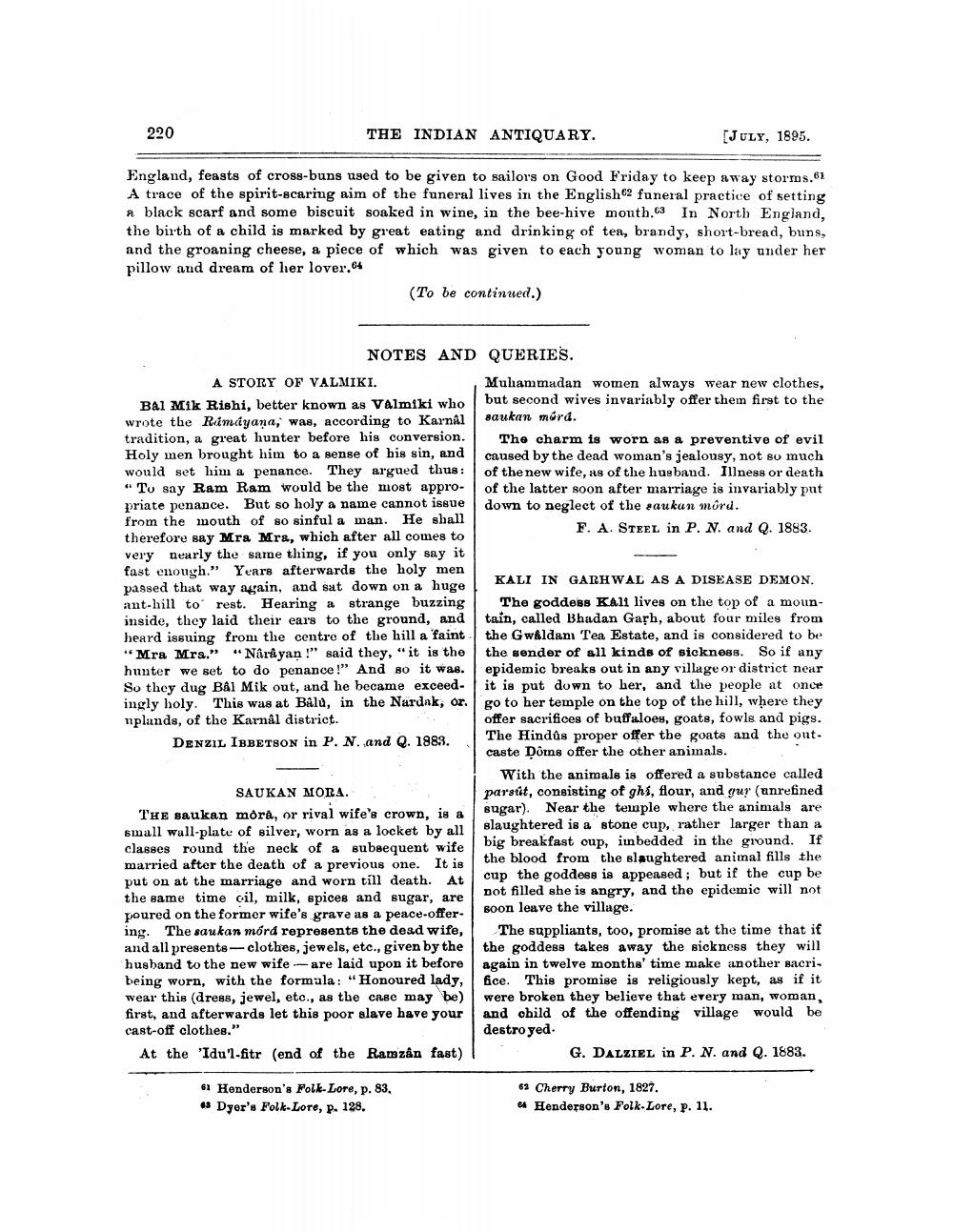________________
THE INDIAN ANTIQUARY.
[JULY, 1895.
England, feasts of cross-buns used to be given to sailors on Good Friday to keep away storms.61 A trace of the spirit-scaring aim of the funeral lives in the English2 funeral practice of setting a black scarf and some biscuit soaked in wine, in the bee-hive mouth.63 In North England, the birth of a child is marked by great eating and drinking of tea, brandy, short-bread, buns, and the groaning cheese, a piece of which was given to each young woman to lay under her pillow and dream of her lover.64
(To be continued.)
220
NOTES AND QUERIES.
A STORY OF VALMIKI.
Bal Mik Rishi, better known as Valmiki who wrote the Ramayana, was, according to Karnal tradition, a great hunter before his conversion. Holy men brought him to a sense of his sin, and would set him a penance. They argued thus:
To say Ram Ram would be the most appropriate penance. But so holy a name cannot issue from the mouth of so sinful a man. He shall therefore say Mra Mrs, which after all comes to very nearly the same thing, if you only say it fast enough." Years afterwards the holy men passed that way again, and sat down on a huge ant-hill to rest. Hearing a strange buzzing inside, they laid their ears to the ground, and heard issuing from the centre of the hill a faint "Mra Mrs." "Narayan!" said they, "it is the hunter we set to do penance!" And so it was. So they dug Bål Mik out, and he became exceedingly holy. This was at Bâlu, in the Nardak, or. uplands, of the Karnål district.
DENZIL IBBETSON in P. N. and Q. 1883.
SAUKAN MORA.
THE saukan mora, or rival wife's crown, is a small wall-plate of silver, worn as a locket by all classes round the neck of a subsequent wife married after the death of a previous one. It is put on at the marriage and worn till death. At the same time cil, milk, spices and sugar, are poured on the former wife's grave as a peace-offering. The saukan mórá represents the dead wife, and all presents-clothes, jewels, etc., given by the husband to the new wife - are laid upon it before being worn, with the formula: "Honoured lady, wear this (dress, jewel, etc., as the case may be) first, and afterwards let this poor slave have your cast-off clothes."
At the 'Idu'l-fitr (end of the Ramzân fast)
61 Henderson's Folk-Lore, p. 83.
65 Dyer's Folk-Lore, p. 128.
Muhammadan women always wear new clothes, but second wives invariably offer them first to the saukan mora.
The charm is worn as a preventive of evil caused by the dead woman's jealousy, not so much of the new wife, as of the husband. Illness or death of the latter soon after marriage is invariably put down to neglect of the saukan môrd.
F. A. STEEL in P. N. and Q. 1883.
KALI IN GARHWAL AS A DISEASE DEMON.
The goddess Kali lives on the top of a mountain, called Bhadan Garh, about four miles from the Gwâldanı Tea Estate, and is considered to be the sender of all kinds of sickness. So if any epidemic breaks out in any village or district near it is put down to her, and the people at once go to her temple on the top of the hill, where they offer sacrifices of buffaloes, goats, fowls and pigs. The Hindus proper offer the goats and the outcaste Doms offer the other animals.
With the animals is offered a substance called parsût, consisting of ghi, flour, and gur (unrefined sugar). Near the temple where the animals are slaughtered is a stone cup, rather larger than a big breakfast oup, imbedded in the ground. If the blood from the slaughtered animal fills the cup the goddess is appeased; but if the cup be not filled she is angry, and the epidemic will not soon leave the village.
The suppliants, too, promise at the time that if the goddess takes away the sickness they will again in twelve months' time make another sacri. fice. This promise is religiously kept, as if it were broken they believe that every man, woman, and child of the offending village would be destroyed.
G. DALZIEL in P. N. and Q. 1883.
62 Cherry Burton, 1827.
CA Henderson's Folk-Lore, p. 11.




